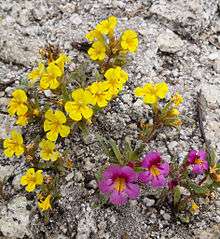Diplacus mephiticus
Diplacus mephiticus is a species of monkeyflower known by the common names skunky monkeyflower and foul odor monkeyflower. It was formerly known as Mimulus mephiticus.[1][2][3][4]
| Diplacus mephiticus | |
|---|---|
 | |
| Scientific classification | |
| Kingdom: | Plantae |
| Clade: | Tracheophytes |
| Clade: | Angiosperms |
| Clade: | Eudicots |
| Clade: | Asterids |
| Order: | Lamiales |
| Family: | Phrymaceae |
| Genus: | Diplacus |
| Species: | D. mephiticus |
| Binomial name | |
| Diplacus mephiticus (Greene) G.L.Nesom | |
| Synonyms[1] | |
| |
It has been reclassified as Mimulus nanus (now Diplacus) var. mephiticus.[5][6]
Distribution
The species is native to the Sierra Nevada and western Great Basin of California and Nevada.
Description
Mimulus nanus var. mephiticus is a diminutive summer annual growing to a height of 15 cm (usually much smaller, especially at high elevation).
The oppositely arranged leaves are linear or lance-shaped and up to 3 centimeters in length. The leaves emit an unpleasant scent when crushed, the characteristic that earned the plant its name.[7]
The trumpet-shaped flower may be up to 2 centimeters long and has an upper lip with two lobes and a lower lip with three. The flower is magenta or yellow, and populations occasionally have plants with both colors. The lower lip of the flower is marked with purplish lines and spots.
See also
- List of plants of the Sierra Nevada (U.S.)
- Flora of the Sierra Nevada (U.S.)
- Diplacus nanus
References
- Barker, W.R.; Nesom, G.L.; Beardsley, P.M.; Fraga, N.S. (2012), "A taxonomic conspectus of Phrymaceae: A narrowed circumscriptions for Mimulus, new and resurrected genera, and new names and combinations" (PDF), Phytoneuron, 2012–39: 1–60CS1 maint: uses authors parameter (link)
- Beardsley, P. M.; Yen, Alan; Olmstead, R. G. (2003). "AFLP Phylogeny of Mimulus Section Erythranthe and the Evolution of Hummingbird Pollination". Evolution. 57 (6): 1397–1410. doi:10.1554/02-086. JSTOR 3448862.
- Beardsley, P. M.; Olmstead, R. G. (2002). "Redefining Phrymaceae: the placement of Mimulus, tribe Mimuleae, and Phryma". American Journal of Botany. 89 (7): 1093–1102. doi:10.3732/ajb.89.7.1093. JSTOR 4122195. PMID 21665709.
- Beardsley, P. M.; Schoenig, Steve E.; Whittall, Justen B.; Olmstead, Richard G. (2004). "Patterns of Evolution in Western North American Mimulus (Phrymaceae)". American Journal of Botany. 91 (3): 474–4890. doi:10.3732/ajb.91.3.474. JSTOR 4123743. PMID 21653403.
- Jepson Mimulus nanus var. mephiticus' . accessed 3.30.2015
- USDA Mimulus nanus var. mephiticus' . accessed 3.30.2015
- Blackwell, L. R. (2006). Great Basin Wildflowers. Globe Pequot. 171.
External links
- Calflora Database: Mimulus nanus var. mephiticus (Skunky monkeyflower)
- Jepson eFlora (TJM2): Mimulus nanus var. mephiticus
- USDA Plants Profile for Mimulus nanus var. mephiticus (foul odor monkeyflower)
- UC Photo gallery
| Wikimedia Commons has media related to Diplacus mephiticus. |